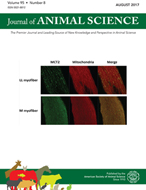-
Views
-
Cite
Cite
R. D. Goodrich, J. E. Garrett, D. R. Gast, M. A. Kirick, D. A. Larson, J. C. Meiske, Influence of Monensin on the Performance of Cattle, Journal of Animal Science, Volume 58, Issue 6, June 1984, Pages 1484–1498, https://doi.org/10.2527/jas1984.5861484x
Close - Share Icon Share
Summary
Performance data on nearly 16,000 head of cattle that were used in trials to document effects of monensin on feedlot cattle were summarized. Cattle fed monensin-containing diets gained 1.6% faster, consumed 6.4% less feed and required 7.5% less feed/100 kg gain than cattle fed control diets. Monensin resulted in the greatest improvement in feed/ gain at 2.9 Meal metabolizable energy (ME)/kg diet dry matter (DM). Within the range of monensin concentrations used in the trials that were summarized (31.8 ± 7.5 mg/kg DM), high monensin concentrations did not improve feed/gain over that obtained with lower concentrations. Carcass characteristics were not significantly influenced by monensin. Responses of cattle to monensin and implants were additive. Energy metabolism data suggested that monensin improved digestibility of DM, reduced fasting heat production and increased dietary net energy maintenance (NEm) values more than it increased net energy gain (NEg) values. Data showing the response of cattle to monensin when fed various dietary protein concentrations or sources of supplemental N suggested that monensin had a protein sparing effect. Monensin has also been shown to reduce lactic acid production, aid in the control of coccidia and bloat and to be toxic to face and horn fly larva in feces of monensin-fed cattle. In pasture trials, monensin improved daily gains. When fed to beef cows, monensin reduced amounts of feed required to maintain cow weight.





